When Def Jam Vendetta hit store shelves last year, it could not have been called anything but an out-of-left-field success. EA's seemingly unholy marriage of Aki Corporation's highly regarded wrestling-game engine with a hip-hop-themed street-fighting game featuring some of the rap business' top talent seemed like, at best, an oddball combination. But, somehow, the game not only worked, it worked extremely well, managing to create one of the most unique grapplers of this console generation. Unsurprisingly, EA Games has followed up the success of Vendetta with a sequel, Def Jam: Fight for NY. More hip-hop stars, more fighting styles, a much deeper story mode, and a big, fat M rating are the name of game in Fight for NY. No doubt, this is a more brutal, bloody, and foul-mouthed effort than last year's game, but this emphasis on mature content is backed up by great gameplay and an incredible atmosphere, effectively trumping Vendetta in every way that matters and making for a game that should appeal to hip-hop fans and fighting-game players alike.

While last year's Vendetta may have been solely a wrestling game in the eyes of most, Fight for NY takes the Aki engine and tweaks it quite a bit, speeding up the pace of the action and putting more focus on unique fighting styles than the standard strikes and grapples of old. Essentially, each of the fighters in Fight for NY draws his or her individual move set from one to three of the game's five fighting styles, including kickboxing, street fighting, martial arts, wrestling, and submissions. All these styles are translated through what is, in essence, the same basic gameplay engine Vendetta used, but with a much, much higher emphasis on learning the styles and moves of your opponents. The varying combinations of each style of fighting make trying to predict how each fighter will attack fairly difficult for at least your first couple of fights, thus forcing you to observe each fighter and how he or she works.
Likewise, as no two fighters fight exactly alike, the controls from fighter to fighter vary a bit. Fundamentally, fighting is still rooted in the same weak and strong strikes and grapples of last year's game, but the way each attack works depends entirely on your fighter's style. If you have a guy who has a background in kickboxing and wrestling, and you've put your opponent into a grapple, you'll perform some manner of slam move by pressing one of the attack buttons and unleash a fury of grappling strikes with the other. Similarly, if you switch out kickboxing with submissions, that second attack button will throw your opponent into a submission-type maneuver. This same methodology translates into strikes, as the kind of striking styles your fighter uses will directly affect how strong his or her strikes are, as well as how lengthy his or her combos will tend to be. Plus, allotted styles dictate what kinds of moves a fighter can use to KO an opponent, so a fighter with a wrestling background will be less likely to KO an opponent with a strong kick than he or she will be with, say, a strong power slam. There's a surprising amount of depth here, to be sure.
Another layer of depth is added to fights thanks to the in-game environments. Each and every environment features at least a few interactive elements, including the crowds. If you whip your opponent into the crowd, one of a couple of things will happen. Either the crowd will shove your opponent back at you, giving you a shot at an easy attack, or they'll hold onto him or her, letting you come in for a couple of quick strikes or a special grapple attack. They'll even crack a weapon over your opponent's skull, if they happen to be holding one at the time. Crowds aren't the only portion of the environments you can interact with, of course. If there's a solid wall or an object in an environment, you can slam your opponent into it any number of different ways, resulting in some pretty hefty damage.
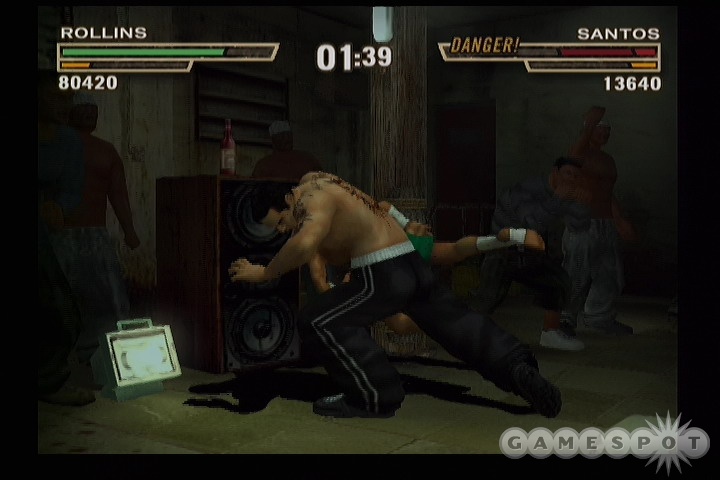
However, while the game's fighting system definitely has depth, it also suffers from a bit of repetitiveness too. This is basically the result of the game being as fast as it is--which is to say, very fast. It's rare that you'll ever have much time to really plot out your attacks beyond the basic decision to use a strike or a grapple, so it's likely that you'll find yourself using a lot of the same moves over the course of a match. Of course, thanks to the sheer brutality and entertainment value associated with the game's action, it's also pretty likely that you won't care much about the occasional repetitiveness. Just about every single punch, kick, slam, crack, and smash in the game looks and sounds incredibly painful, and the healthy spurts of blood that come spewing forth from your opponent further add to the brutality of it all. This game has a mean spirit to it, but that spirit definitely works to its advantage.
Following the same formula as Def Jam Vendetta, Fight for NY's roster of combatants is largely made up of a list that, despite a real lack of Bay Area artists like E-40 or Too Short, looks like it could easily be the performer list for this year's Source Awards. Snoop Dogg, Xzibit, Method Man, Redman, WC, Mack 10, Ice-T, Busta Rhymes, Fat Joe, Slick Rick, Erick Sermon, Flava Flav, Warren G, Lil' Kim, David Banner, Ghostface Killah--these are just some of the roughly 40 hip-hop artists who make an appearance in the game. And they're not alone, either. Along with a healthy smattering of generic characters, other celebrities such as Dracula 2000 and Juice star Omar Epps, Dave Navarro arm-candy Carmen Electra, renowned tough-guy character actor Danny Trejo, and modern-day renaissance man Henry Rollins all make appearances as well. Fight for NY features what is easily one of the most bizarrely eclectic mixes of real-life personalities ever to be found in a game, but somehow it manages to make it work. However, even better than the characters already available in the game are the ones you can make yourself.
Def Jam: Fight for NY's story mode gives you the opportunity to create your own brand of street thug, thanks to a myriad of creation options ranging from simple body and facial features to gear, hairstyles, and jewelry. But let's not get ahead of ourselves--before you can get iced up, you'll have to begin the story. Last year's story mode left a little something to be desired. It was a well-told tale about an up-and-coming fighter in the Def Jam-themed New York fighting circuit, but it was a little too short to make any sort of real impact. Fight for NY's story mode happens to pick up right where Vendetta left off, with the figurative king of New York, D-Mobb--the same malicious fellow you dethroned in the first game--being arrested by the boys in blue. As he is being carted off to the station house, a mysterious car comes out of nowhere and blindsides the cop car, providing D-Mobb with a method of escape. As it turns out, the driver of that mysterious vehicle was none other than you.
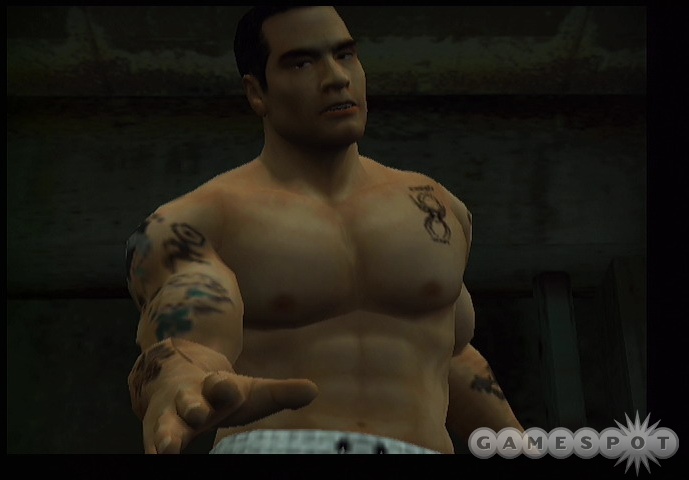
In the aftermath of D-Mobb's escape, the officers involved are left to try to describe the perpetrator of the accident. Through the magic of sketch artistry, you create the basic features of your fighter, including body type, eyes, nose, ears, skin tone, hair, and even voice type. Once that's out of the way, you'll see your character for the first time as he and D-Mobb enter his gang's hideout. You experience a brief exchange with some of D-Mobb's posse, and then faster than you can say "Because he kept me out of handcuffs!" you've joined up with D-Mobb's set and are on your way to becoming a top combatant in the New York underground fighting circuit.
Most of the actual plotline revolves around D-Mobb's boys going up against an evil crew run by Snoop Dogg's character, Crow. That's right, Snoop isn't actually playing his usual pimped-out self. Rather, he's taken on the persona of a mean, nasty gang leader who is trying to take control of New York's fight scene from D-Mobb. In fact, every personality in the game is playing some manner of character. Some keep their stage names, and others, such as Snoop, Method Man, and Busta Rhymes, take on character names. Some of the characterizations, such as Busta Rhymes' sneeringly evil character, are a tad more of a stretch, whereas Redman's Doc character, who spends the first third of the story sleeping on a couch, seems pretty true to life. In any case, having the rappers play characters rather than weird amalgamations of themselves and sort-of characters like in last year's game has definitely made for a more interesting story this time around.
The progression of Fight for NY's story mode isn't too complex. Once you've completed a short training sequence, you'll find yourself inside the apartment that will serve as the hub area for your character. Your crib features several sections that you can access, including a cell phone for checking messages, a closet to manage your wardrobe, a trophy case to display your accomplishments in the game, and a map of the city. On the map you will see where active fights are set to take place. The progression of the story through the map system is somewhat nonlinear, in that you can choose to fight at any active location. However, only specific fights will trigger cutscenes and other bits of the storyline, so in that sense, the story does lean more toward linearity.
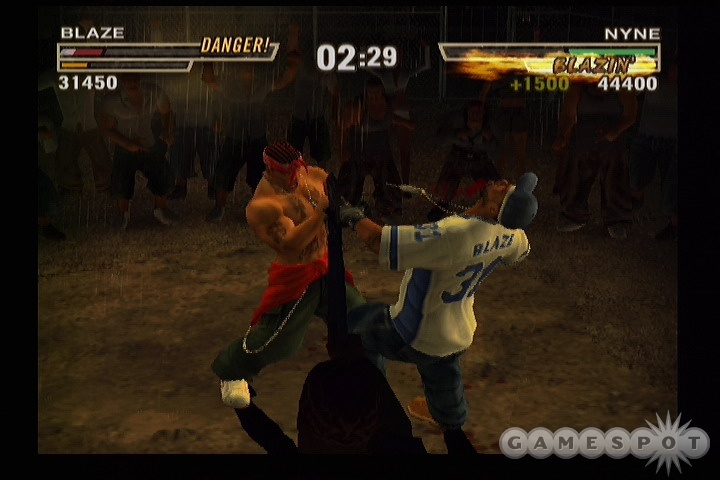
Aside from fights, you can also access a number of shops from the map, as well as your training gym. Shops include a barbershop, a clothing store, a tattoo parlor, and a jewelry store run by none other than the ice specialist to the rap stars, Jacob the Jeweler. With the money you earn from fights, you can purchase anything available from these stores, and there is quite a lot to choose from. The clothing store alone is packed with name-brand gear from companies like Sean John, Ecko, Fila, and a host of other clothiers. The interesting thing about the character customization is that it actually plays into your character's charisma rating. Jewelry pieces purchased from Jacob especially fall into this category, as your charisma rating essentially gets jacked up with every piece of flash you show off. The more money you spend, the more the crowd will eat it up. The best part about all the gear you get is that it fits onto your character perfectly. So often in games of this type, the clothes and accessories you add don't look like a good fit for the character, and rather just look badly pasted onto the model. Here, the accessorial changes are seamless.
The gym is the other area where you can make purchases, albeit completely different sorts of purchases. Managed by Henry Rollins, the gym is where you'll be able to upgrade your character's physical attributes, including upper-body strength, lower-body strength, speed, toughness, and health. These attributes are upgraded via points you also earn from fighting, and as you boost them up, the cost for each attribute bonus gets higher. You can also purchase new "blazin' moves," which are over-the-top finishing maneuvers that are equally hysterical and brutal. There's a whole mess of moves to choose from, and as you work your way through the fighting circuit, you'll unlock many of your fallen opponents' moves, which can then be bought at the gym. The gym is also where your character will develop new fighting styles. At the outset, you'll have only one style chosen, but once you earn enough points, you can learn a second and finally a third style to give your character a nice variety of attacks.
All in all, Fight for NY's story mode is a whole lot of fun. It's a reasonably lengthy affair (it'll take you roughly eight hours to get through the whole thing), and it's entertaining throughout. The only real complaint about the story is that it doesn't always make a ton of sense. For starters, the game never really explains why D-Mobb has suddenly gone from the brutal tyrant he was in the first game to the streetwise but respected gang leader he is in the sequel--in fact, he actually borders on being one of the good guys. The game also never really pays any heed to who your character actually is, or where he came from, nor does it provide any satisfying conclusion once it has played itself out (in fact, the ending is more than a little anticlimactic). Furthermore, the story has just a few too many convenient changes of heart from various secondary characters to really be at all believable. But, plot holes aside, the point of the story is not to be some gritty, hard-nosed, realistic drama about street fighting. This is a campy, over-the-top thug story with a lot of celebrities voicing some pretty stereotypical characters, and in this sense, the game succeeds wonderfully. Plus, when you factor in the sheer number of fights to participate in, and the insane amount of character customization available to you, these quibbles can be easily ignored.
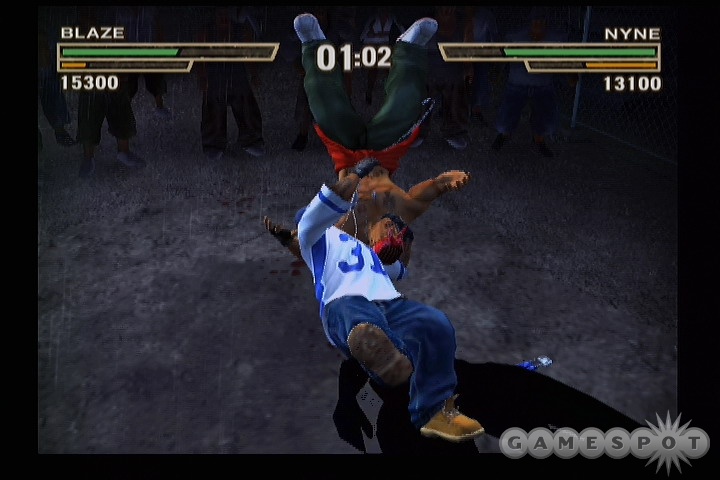
Once you've had your way with the story mode, you'll find yourself turning to Fight for NY's multiplayer matches, of which there are plenty. Every type of fight you can participate in from the story mode is available in the game's battle mode, ranging from simple brawls in basements and bars to cage matches, subway matches, demolition matches, inferno matches, window matches, and beyond. Just to give you a couple of examples of what some of these crazier matches are like, the subway match challenges you to fight inside a subway station and beat your opponent either by knocking him or her out or by throwing him or her in front of an oncoming subway train. Demolition matches take place inside a parking garage, and within your fight area are two SUVs. You can use these as weapons by throwing your opponent through the windshield, tossing him or her onto the hood, or smashing him or her in the door. The game also features two-on-two team battles, as well as a free-for-all match for up to four players. The only feature missing here (on the PS2 and Xbox anyway) is online connectivity, and this is disappointing. However, there's more than enough offline multiplayer variety to keep Fight for NY entertaining, so long as you have some friends who are willing to come over and play along with you.
Graphically, Fight for NY is a pretty significant step up from Def Jam Vendetta. The models for the various celebrity characters are extremely impressive, highly detailed likenesses of their real-life counterparts. Sure, some of the body builds have been beefed up here and there to try to make them look more physically intimidating (sorry, Ice-T, you're not that cut), but really, who cares? The game's variety of battle arenas is also very impressive. Each area is quite distinctive, ranging from a Rasta-themed Jamaican bar and a deserted scrap yard to a Fight Club-style basement, complete with cardboard tossed about the floor to try to soak up some of the spilled blood. The crowd models aren't especially detailed, but they animate well enough and react to the action accordingly. The little sections of each environment that are destructible also come off nicely, breaking beautifully on impact. A fair portion of the game's move animations are holdovers from last year's game, but there's also a huge variety of new moves (especially in the blazin' move category), and they all look great.
There are also some really nice technical touches you'll see throughout the game, as well as a couple of technical annoyances. Most noticeably, in the Xbox and PS2 versions of the game, you'll notice something of a soft light-blur effect that permeates each fight. This little touch of haze really gives each fight a slick, smooth look to it. It's unfortunate that the GameCube version of the game lacks this, but it isn't really much worse for the wear without it. The only issues that really plague the game are an occasionally annoying camera and an unfortunately erratic frame rate. The camera problem is extremely infrequent, but if you get too close the bottom of the screen, the wall or crowd of people standing there sometimes won't become fully transparent, which obscures your field of vision. As for the frame rate, it's basically all over the place on all three consoles. The number of fighters in a fight at once seems to have no bearing on this problem, as even a two-on-two fight produces a fair amount of frame drop at seemingly random intervals. It's really unfortunate that this occurs, as it does mar what is an otherwise superb visual experience.
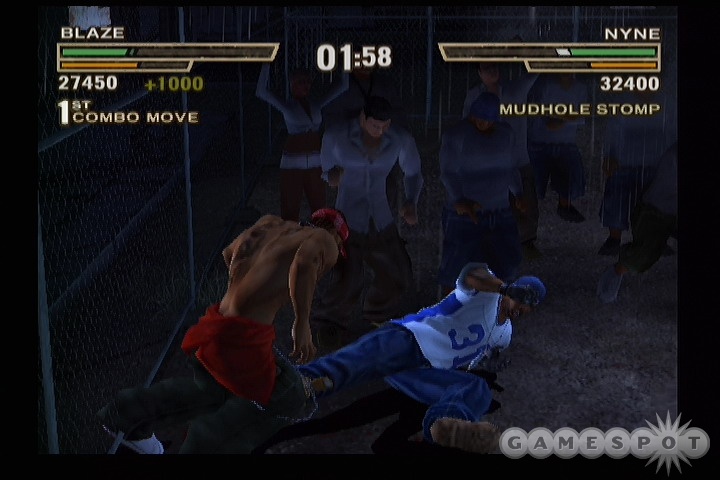
Audio is another category where Fight for NY excels. Def Jam Vendetta managed to elicit some surprisingly competent and enjoyable voice acting from the cadre of rappers hired to perform in that game, and Fight for NY is no different. Though many of the rappers are relegated to speaking only an intro and an end-of-match line, quite a number of the hip-hop artists have significant roles in the storyline, and they do a very good job with the dialogue handed to them. The dialogue itself is well written and rarely ever seems forced, despite the fact that it's quite profane in nature. However, the profanity always fits into the context of the situation, so it's not like people are just dropping "F" bombs every six seconds for no good reason. The soundtrack is a fantastic mix of old and new hip-hop, and much of it comes from the artists featured in the game. During a match, you'll hear instrumental versions of the songs, but the menus feature full tracks. Many of the game's sound effects seem largely lifted from last year's game, but it all works excellently and is hardly anything to complain about.
Def Jam: Fight for NY is a great sequel. It would have been easy for the developers behind this game to just crank out an incremental upgrade, but Fight for NY is anything but incremental--it feels like a whole different brand of game altogether. What worked in Def Jam Vendetta has been expanded and improved upon in almost every way, and the new story mode, complete with its character creation and customization element, is simply a joy to play through. If you like wrestling games, fighting games, or even just the world of hip-hop, Def Jam: Fight for NY is a game well worth owning.